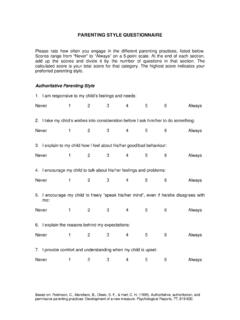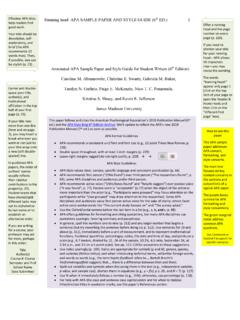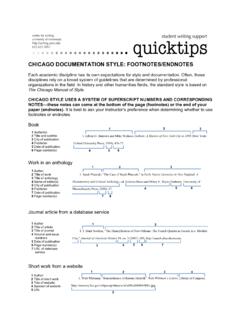Transcription of APA DOCUMENTATION STYLE - SUNY Polytechnic Institute
1 APA DOCUMENTATION STYLE * Source: 6th Edition of the Publication Manual of the American Psychological Association (2009). RF 9/09 APA DOCUMENTATION STYLE is a method for listing the sources you use so that your readers can identify and find those sources. It is commonly used in the social sciences, for example, business, history, psychology and sociology. The examples below can be templates for your own citations. CITING SOURCES IN THE BODY OF YOUR PAPER Cite entire works within your paper with parenthetical author-date references (Foster, 2003), but if you are using direct quotations with quotation marks then use author-date-page number references (Foster, 2003, p.)
2 311). These citations will correspond to sources listed alphabetically by author at the end of your paper in a References section. Sources without an author are listed by their title. CITING BOOKS [More information is available in the Manual: pp. 202-5*] Formula: Author, A. A. (Date of Publication). Title of book. Location: Publisher. Example: Gladwell, M. (2008). Outliers: The story of success. New York: Little, Brown. CITING JOURNAL ARTICLES [More information: pp. 198-202*] Formula: Author, A. A. (Year of Publication). Title of article. Title of Journal, volume, page numbers.
3 Doi Examples: Sevincer, A. T., & Oettingen, G. (2009). Alcohol breeds empty goal commitments. Journal of Abnormal Psychology, 118, 623-633. doi: Hunter, W. S. (1946). Psychology in the war. American Psychologist, 1, 479-492. Include the digital object identifier (DOI) if it is available. There is no period after the DOI. If there is no DOI and you retrieved it online, include the home page address of the journal by using the sentence: Retrieved from If there is no journal home page address then skip it. If each issue begins on page 1, give the issue number in parentheses after the volume number.
4 Magazines are cited in a similar way but include the month of publication & the issue number. APA STYLE no longer requires the date you accessed the article nor the database s name. CITING NEWSPAPER ARTICLES [More information: p. 200*] Formula: Author, A. A. (Year, Month Day). Article title. Newspaper Title, pp. X, XX. Example: Segal, D. (2009, September 7). Gadget makers can find thief, but don t ask. The New York Times, pp. A1, B2. APA DOCUMENTATION STYLE * Source: 6th Edition of the Publication Manual of the American Psychological Association (2009). RF 9/09 CITING NON-PAPER SOURCES 1.
5 The Manual says, Choose the example that is most like your source and follow that format. The Manual has 77 different examples of citations. The Manual also says, When in doubt, provide more information rather than less. More information is available online at 2. For works with no author, move the title to the author position (before the date of publication). 3. Capitalize only the first word of the title and of the subtitle, if any, and any proper nouns. Do not place quotation marks around the title. Put the title in italics. 4. Use ( ). when a source does not have a date.
6 5. Do not add a hyphen to a URL if it is longer than one line: break it before most punctuation. Example A: Blog Posting [More information: p. 215*] Scicurious. (2009, August 12). No crybabies in science [Web log message]. Retrieved from Example B: Entry in an Online Reference Work, No Author or Editor [p. 205*] Stochastic. ( ). In Merriam-Webster s online dictionary. Retrieved from Example C: Online Government Report [p. 205*] Department of Health and Human Services, Substance Abuse and Mental Health Services Administration, Center for Mental Health Services.
7 (2007). Promotion and prevention in mental health: Strengthening parenting and enhancing child resilience (DHHS Publication No. CMHS-SVP-0186). Retrieved from Example D: Online Newspaper Article [pp. 200-1*] Mooallem, J. (2009, September 2). The self-storage self. The New York Times. Retrieved from Example E: Podcast [p. 210*] Van Nuys, D. (Producer). (2007, December 19). Shrink rap radio [Audio podcast]. Retrieved from Example F: Posting to a Listserv [p. 215*] Smith, S. (2006, January 5). Re: Disputed estimates of IQ [Electronic mailing list message]. Retrieved from Example G: Web Page with No Author [From: ] New child vaccine gets funding boost.
8 (2001). Retrieved from /










